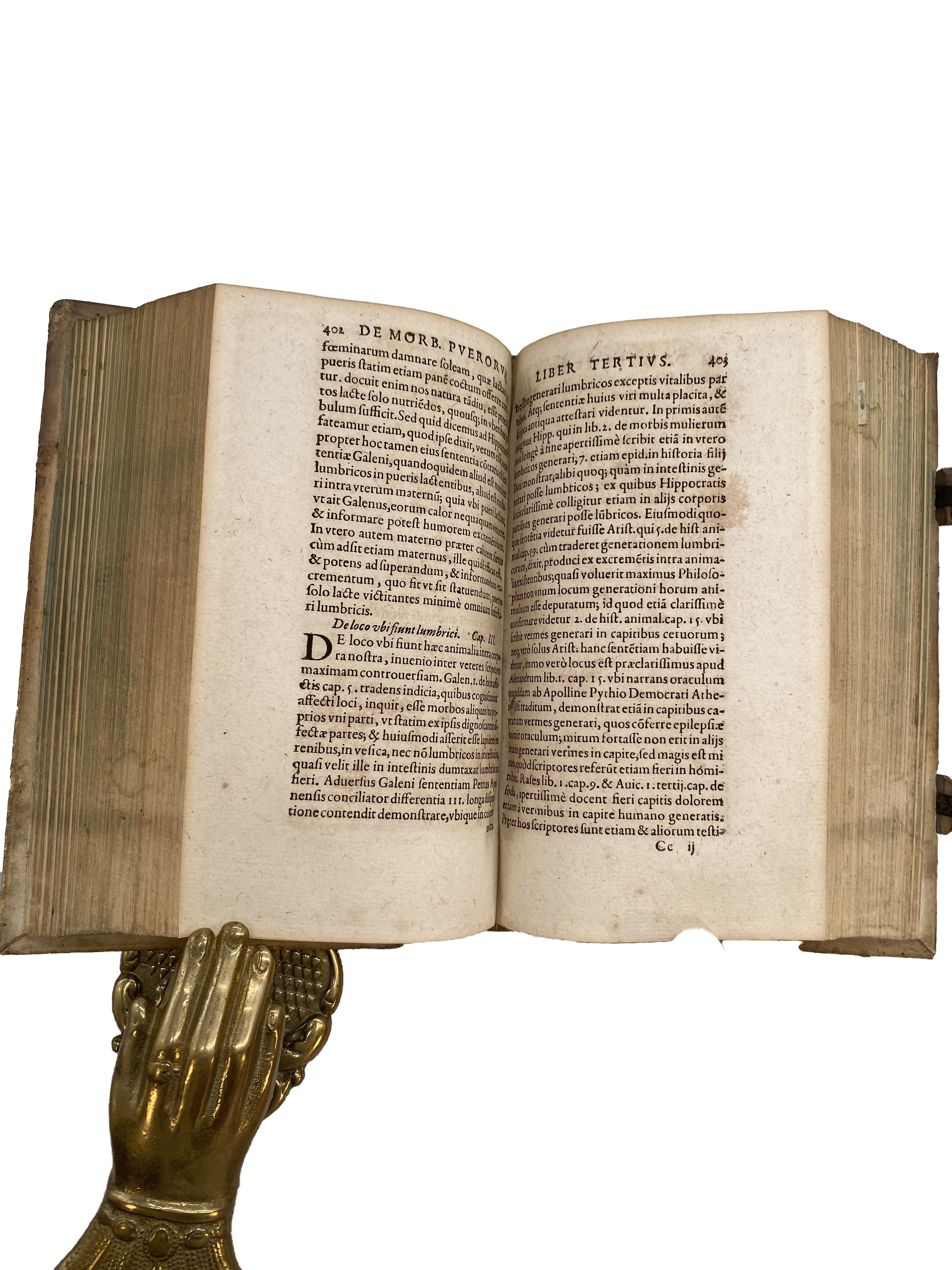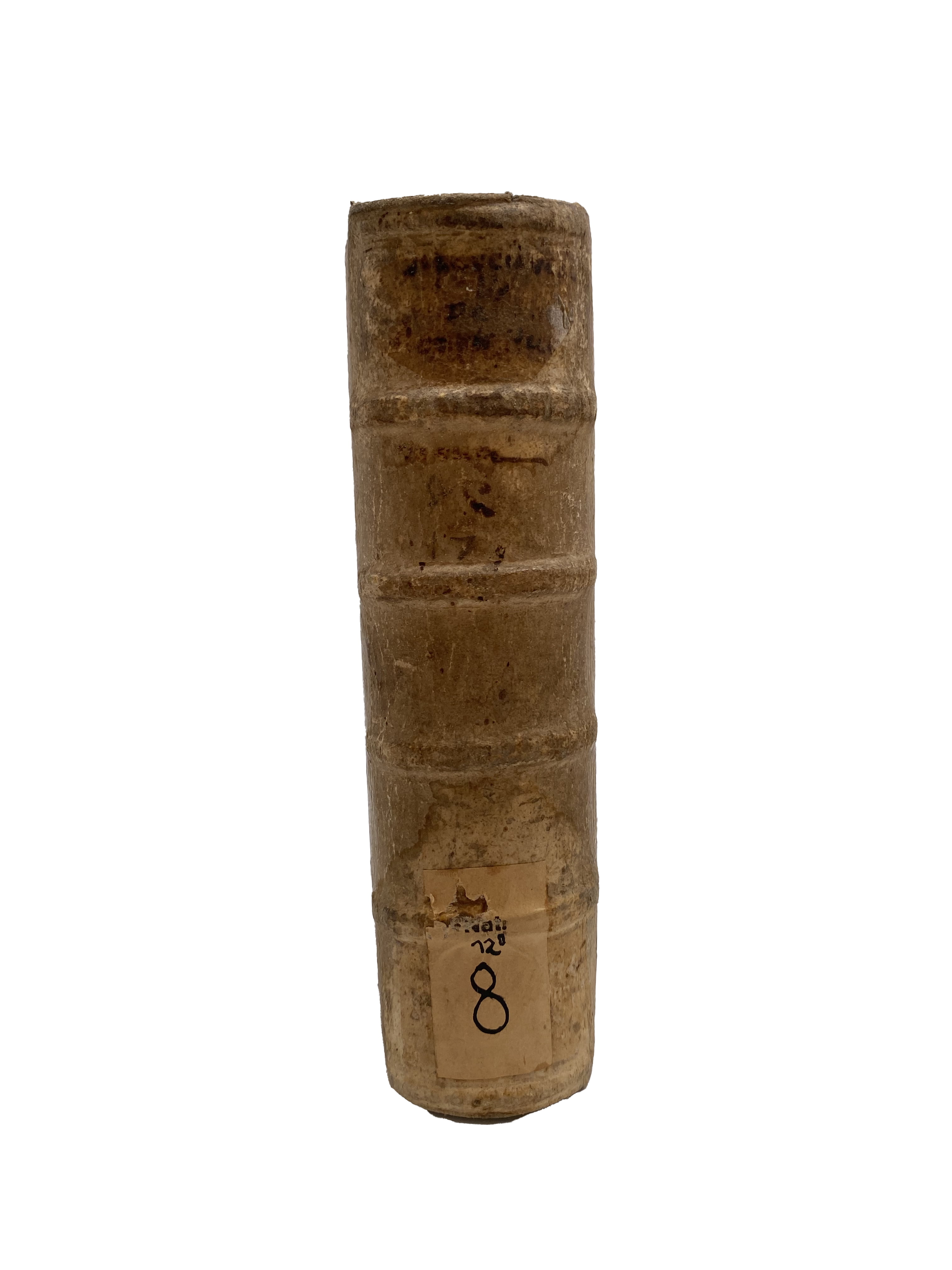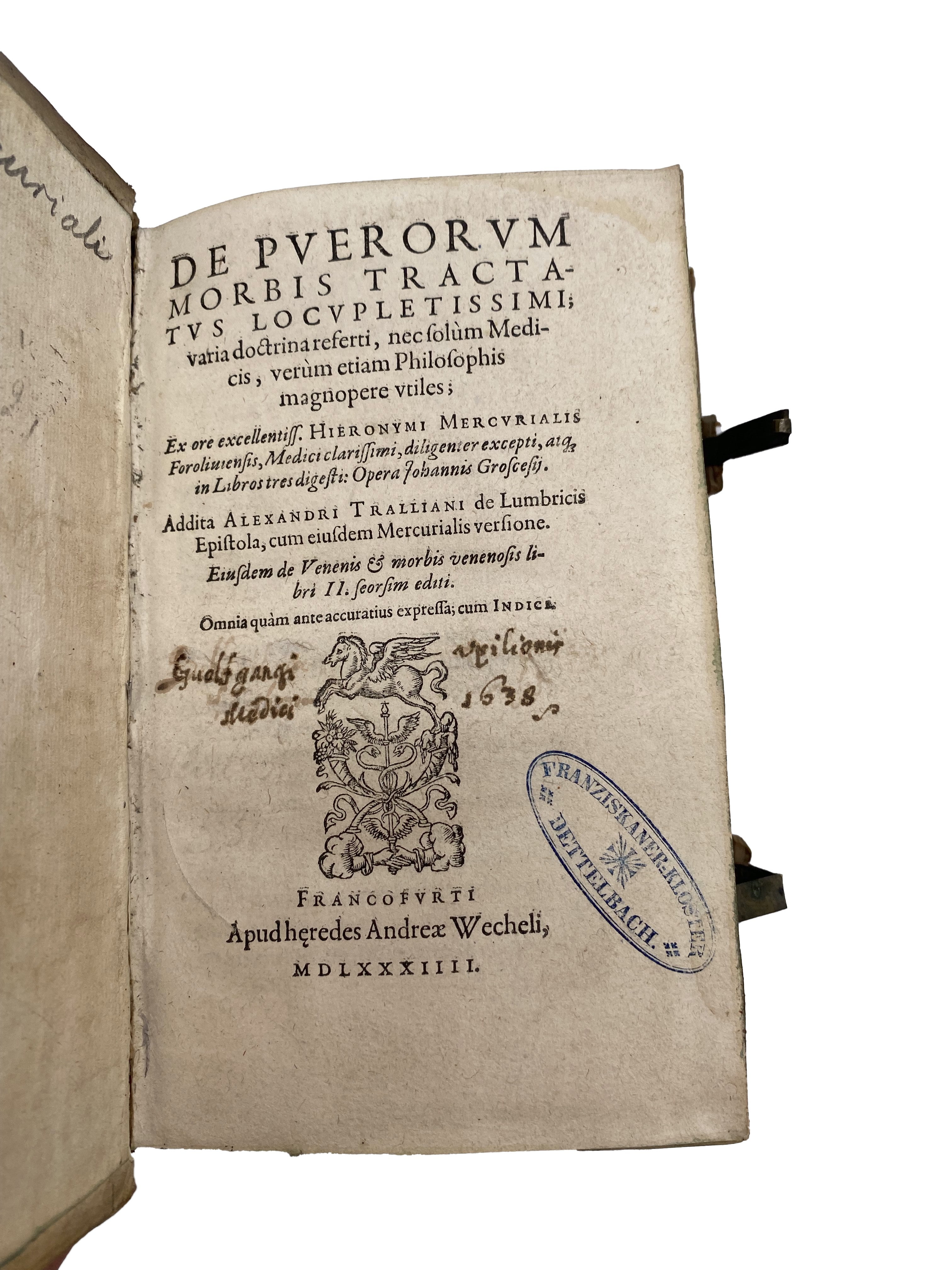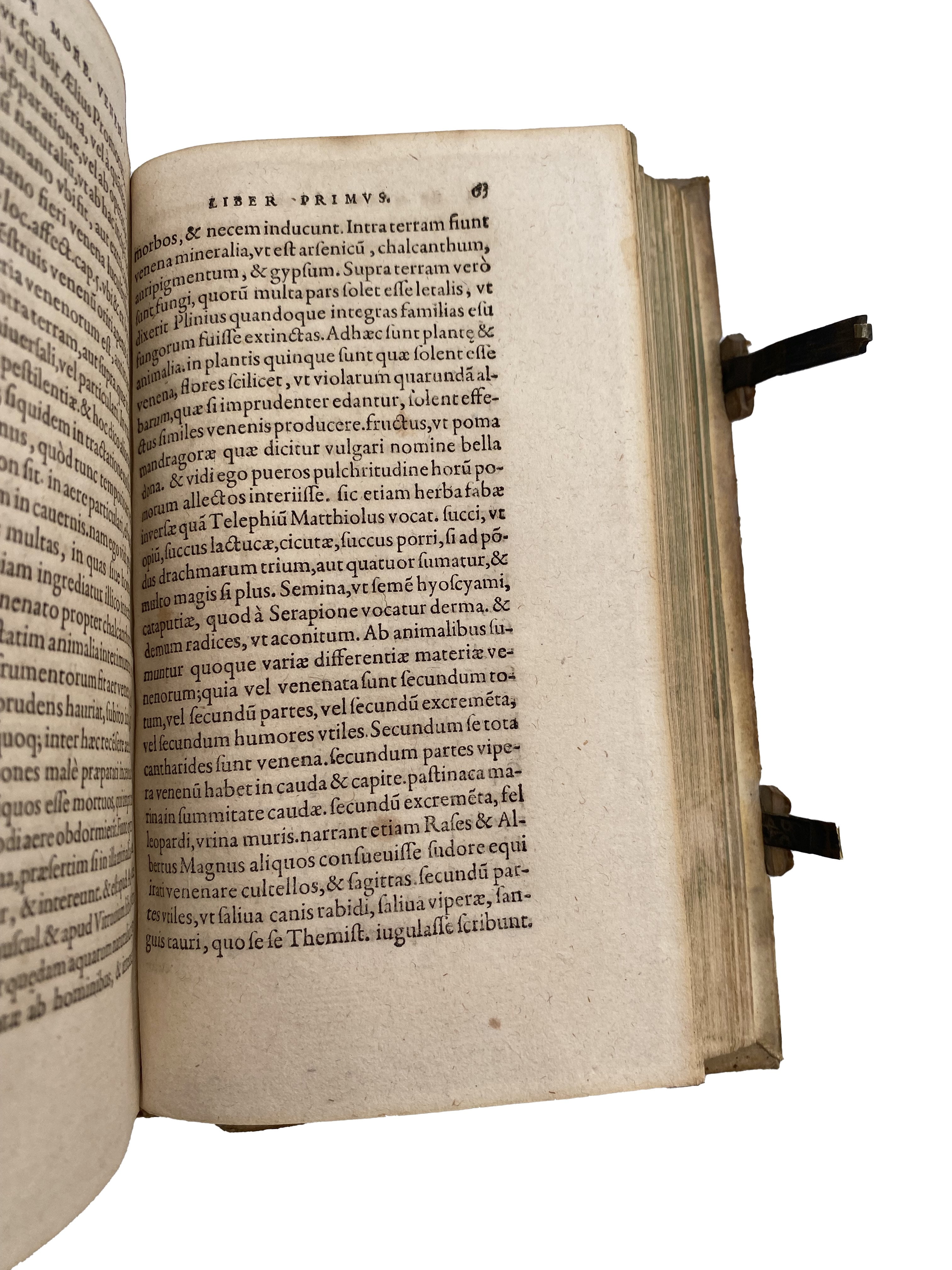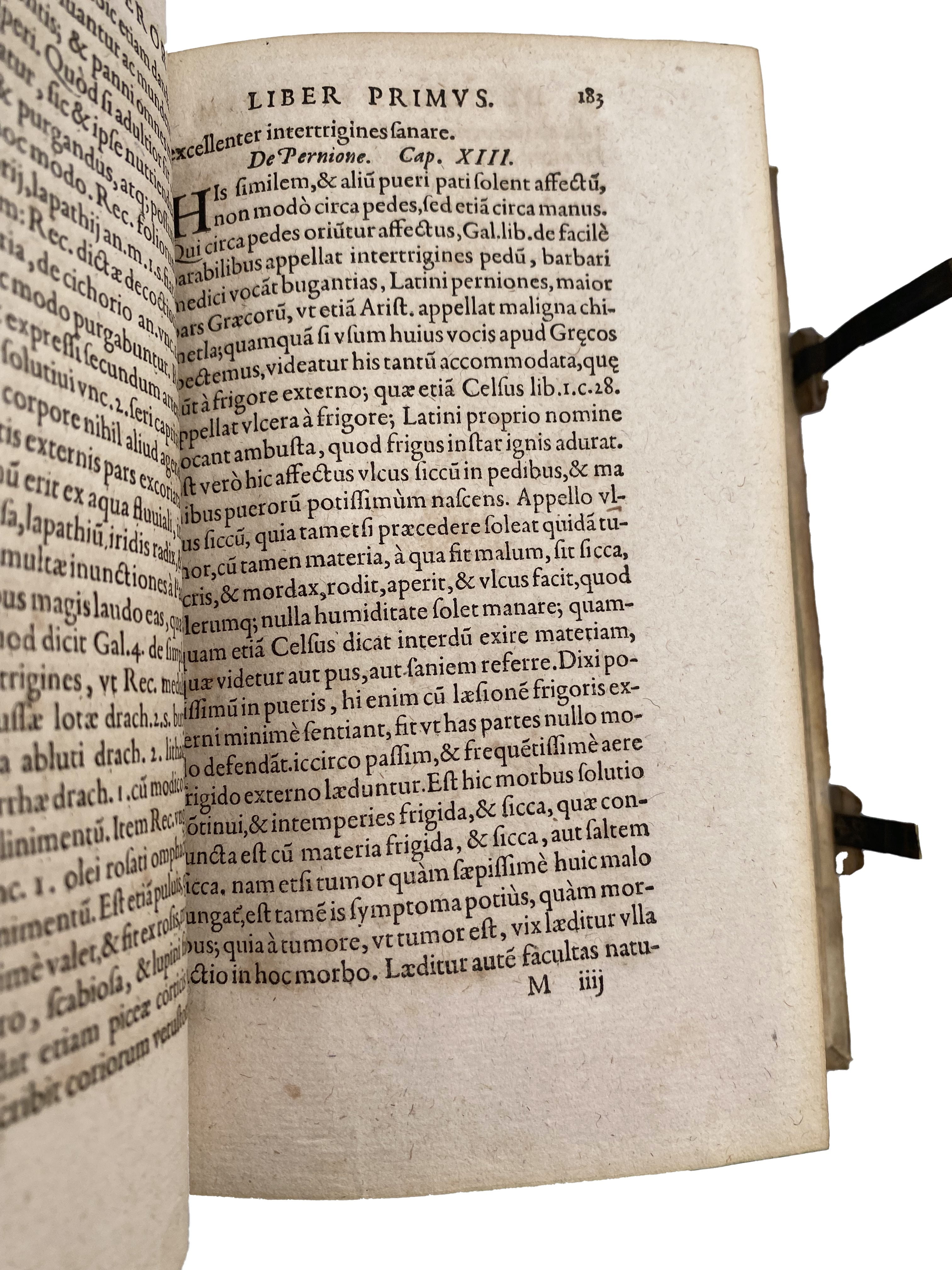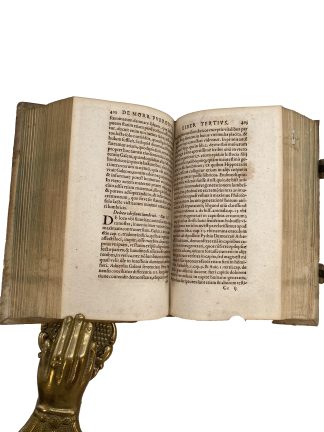MERCURIALE, Girolamo.
De puerorum morbis tractatus […] (with) Eiusdem de venenis et morbis venenosis [with] Censura et dispositio operum Hippocratis
Frankfurt, Andreas Wechel, 1584, 1585£2,750.00
8vo, 3 works in one, FIRST EDITION of second work, printer’s pegasus device to each t-p, pp. (viii) 468 (xxxvi) 168 (8); pp. 47 (i). Roman, Italic and Greek letter, woodcut floriated initials, headpieces with foliage and grotesques, typographical ornaments. Rare marginal foxing, small waterstain to outer edges of a few initial gatherings of second work and some lower blank margins of third, small stain to one fol. of index in second work affecting one letter, very light browning to first gathering of third. A very good, wide margined copy, in contemporary pigskin over wooden boards, covers blind ruled to a panel design, first border with blind stamped roll of heads in roundels and foliage, central panel with three bands of alternating rolls of leaves and flowers. Spine with raised bands, contemporary ms. title to upper compartment, modern paper label to lower, both original decorated brass clasps preserved. Ms. ex libris ‘Guolfgangi Upilionis Medici 1638’ and C19 stamp of the Franciscan monastery of Dettelbach (Germany) to t-p.
Attractive collection of medical works by Mercuriale, in a fine contemporary German blind-stamped binding. In this volume, the second edition of Mercuriale’s pioneering study on children’s diseases (first 1583) – “one of the first books devoted entirely to pediatrics” (Heirs of Hippocrates) together with the first edition of his treatise on poisons. These were bound with the second, expanded edition of Mercuriale’s important ‘Censura Hippocratis’ (first 1583).
‘De morbis puerorum’ (On the diseases of children), is based on the lecture notes taken by one Mercuriale’s students in Padua, the polish Jan Chrościejewski (1555-1628). As explained in the dedication, Chrościejewski, who later gained fame and prestige as a doctor in Poznań, accurately edited his notes into a publication, which was corrected and revised by Mercuriale in person. The treatise is in three books, the first dedicated to ‘external diseases’ and in particular those affecting the skin with rashes. Remarkably, the difference between smallpox and measles is presented here for the very first time, and this section also deals with nutrition disorders which have been properly studied only in the XX century. The second book presents ‘internal diseases’, including fevers, earache, nausea, and speech disorders like mutism and stammering. Interestingly, Mercuriale is one of the first authors to address ‘fear’ in children, mentioned as one of the ‘affections of the mind’ which can cause stammering. The third book is entirely on worms and how to treat them. Highly successful, ‘De morbis puerorum’ was reprinted several times and translated in German in 1605. At the end, in connection with the last book, Wechel included the Greek text and Latin translation by Mercuriale of ‘De vermis epistola’ by the Byzantine Alexander of Tralles (c. 525-605), containing a description of worms and vermifuges. Mercuriale found Tralles’s epistola in the Vatican library, and published it for the first time in 1570.
‘De venenis et morbis venenosis’ (On poisons and poisonous diseases), was also based on Mercuriale’s lectures and edited by a polish student named Wojciech Szeliga (Albertus Scheligius, d. 1585). The first edition was published in 1584 in Frankfurt (here), Venice and Basel at the same time. The first section deals with the nature of venoms, the symptoms of poisoning and how to prevent it, the second describes the most common poisonous animals – for example: vipers, scorpions, tarantulas – and mentions the most used antidotes. Finally, ‘Censura et dispositio operum Hippocratis’, first published in 1583 with the title ‘Censura de Hippocratis operibus’, is one of Mercuriale’s most important historical contributions. In fact, it represents one of the earliest attempts to evaluate the authenticity of the treatises attributed to Hippocrates and distinguish genuine and spurious works.
An Italian physician and philosopher, Girolamo Mercuriale was born in Forlì. After completing his studies in Bologna, Padua and Venice, he obtained a doctoral degree in 1555. He spent seven years in Rome, studying the Greek and Roman medical literature in the great libraries of the city, and later was appointed professor of Medicine in Padua, Bologna and Pisa. An extremely prolific writer, he gained fame thanks to his successful ‘De Arte Gymnastica’ (1569), the first complete text on gymnastics discussing the therapeutic value of sports. Well-known and esteemed at his time, he was even called to Vienna to examine Emperor Maximilian II.
The ex libris on the title page most likely belongs to the German doctor and professor of medicine Wolfgang Upilio (XVII century), born to a family of physicians of Bad Neustadt, Bavaria. His grandfather, Wilhelm (d. 1594) became city doctor in 1572 and was a founding member of the medical faculty of the University of Würzburg; his father, Christoph (c. 1572-1645), became city doctor of Bad Neustadt in 1590. After obtaining his doctorate in philosophy and medicine in Würzburg, Wolfgang was appointed professor in 1637 (Geschichte der Universität Wirzburg, Volume I, 1882, p. 351).
1) USTC 631177; VD16 M4818; Durling 3101; Wellcome I 4240; This ed not in Heirs of Hippocrates, BM STC Ger. 16th century. 2) USTC 662767; VD16 M 4812; Durling 3085; Wellcome I 4242; BM STC Ger. 16th century, p. 620; This ed not in Heirs of Hippocrates.In stock


